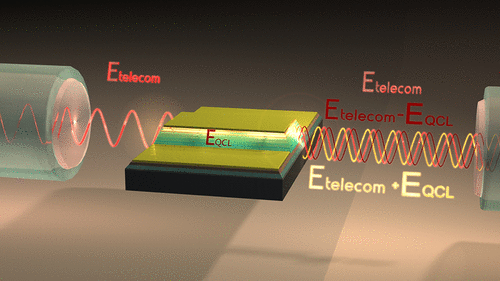当前位置:
X-MOL 学术
›
ACS Photonics
›
论文详情
Our official English website, www.x-mol.net, welcomes your feedback! (Note: you will need to create a separate account there.)
Multi-Terahertz Sideband Generation on an Optical Telecom Carrier with a Quantum Cascade Laser
ACS Photonics ( IF 7 ) Pub Date : 2018-01-12 00:00:00 , DOI: 10.1021/acsphotonics.7b01124 Sarah Houver 1 , Armand Lebreton 1 , Alireza Mottaghizadeh 2 , Maria Ines Amanti 2 , Carlo Sirtori 2 , Gregoire Beaudoin 3 , Isabelle Sagnes 3 , Olivier Parillaud 4 , Raffaele Colombelli 3 , Juliette Mangeney 1 , Robson Ferreira 1 , Jerome Tignon 1 , Sukhdeep Singh Dhillon 1
ACS Photonics ( IF 7 ) Pub Date : 2018-01-12 00:00:00 , DOI: 10.1021/acsphotonics.7b01124 Sarah Houver 1 , Armand Lebreton 1 , Alireza Mottaghizadeh 2 , Maria Ines Amanti 2 , Carlo Sirtori 2 , Gregoire Beaudoin 3 , Isabelle Sagnes 3 , Olivier Parillaud 4 , Raffaele Colombelli 3 , Juliette Mangeney 1 , Robson Ferreira 1 , Jerome Tignon 1 , Sukhdeep Singh Dhillon 1
Affiliation

|
Quantum cascade lasers (QCLs) are the principal semiconductor light sources for the mid-infrared (MIR) and terahertz (THz) spectral regions. However, up-converting their emission to the technologically mature telecom spectral region (1.3 to 1.6 μm) remains an important goal for applications. This would permit new QCL functionalities to be realized, such as stabilization and injection locking of the QCL emission to precise and low-cost telecom frequency combs for spectroscopy. In this work, we demonstrate the up-conversion of the QCL emission to the telecom band at room temperature, using the QCLs’ inherent resonant optical nonlinearities that reduce the constraints of phase matching. This is based on the generation of multi-THz sidebands on a telecom carrier, where a low power telecom beam at 1.55 μm is injected into the cavity of an InP-based MIR QCL (9 μm, 33 THz), giving rise to the nonlinear sum frequency at 1.3 μm. The results are supported by a theoretical model that highlights the giant enhancement of the nonlinear interaction through the resonant telecom excitation and the reduced role of phase matching. As well as potentially bringing important spectroscopic capabilities to QCLs, this compact and low-power all-optical connection between the low-loss transmission windows of 1.3 and 1.55 μm would potentially permit QCLs to be applied as ultrafast wavelength shifters in fiber telecommunication networks.
中文翻译:

带量子级联激光器的光电信载波上的多太赫兹边带生成
量子级联激光器(QCL)是中红外(MIR)和太赫兹(THz)光谱区域的主要半导体光源。然而,将其发射上转换为技术成熟的电信频谱区域(1.3至1.6μm)仍然是应用的重要目标。这将允许实现新的QCL功能,例如QCL发射的稳定化和注入锁定到用于光谱分析的精确且低成本的电信频率梳。在这项工作中,我们利用QCL固有的共振光学非线性特性(减少了相位匹配的约束),证明了在室温下QCL发射向上转换为电信频段的方法。这是基于在电信载波上产生多THz边带的情况,其中低功率电信波束为1。将55μm注入基于InP的MIR QCL(9μm,33 THz)的腔中,从而产生1.3μm的非线性总和频率。结果得到一个理论模型的支持,该模型强调了通过共振电信激励和相位匹配作用的减弱,非线性相互作用的巨大增强。除了可能为QCL带来重要的光谱功能外,1.3和1.55μm的低损耗传输窗口之间的这种紧凑,低功耗的全光连接还可能使QCL可用作光纤电信网络中的超快波长移位器。结果得到一个理论模型的支持,该模型强调了通过共振电信激励和相位匹配作用的减弱,非线性相互作用的巨大增强。除了可能为QCL带来重要的光谱功能外,1.3和1.55μm的低损耗传输窗口之间的这种紧凑,低功耗的全光连接还可能使QCL可用作光纤电信网络中的超快波长移位器。结果得到一个理论模型的支持,该模型强调了通过共振电信激励和相位匹配作用的减弱,非线性相互作用的巨大增强。除了可能为QCL带来重要的光谱功能外,1.3和1.55μm的低损耗传输窗口之间的这种紧凑,低功耗的全光连接还可能使QCL可用作光纤电信网络中的超快波长移位器。
更新日期:2018-01-12
中文翻译:

带量子级联激光器的光电信载波上的多太赫兹边带生成
量子级联激光器(QCL)是中红外(MIR)和太赫兹(THz)光谱区域的主要半导体光源。然而,将其发射上转换为技术成熟的电信频谱区域(1.3至1.6μm)仍然是应用的重要目标。这将允许实现新的QCL功能,例如QCL发射的稳定化和注入锁定到用于光谱分析的精确且低成本的电信频率梳。在这项工作中,我们利用QCL固有的共振光学非线性特性(减少了相位匹配的约束),证明了在室温下QCL发射向上转换为电信频段的方法。这是基于在电信载波上产生多THz边带的情况,其中低功率电信波束为1。将55μm注入基于InP的MIR QCL(9μm,33 THz)的腔中,从而产生1.3μm的非线性总和频率。结果得到一个理论模型的支持,该模型强调了通过共振电信激励和相位匹配作用的减弱,非线性相互作用的巨大增强。除了可能为QCL带来重要的光谱功能外,1.3和1.55μm的低损耗传输窗口之间的这种紧凑,低功耗的全光连接还可能使QCL可用作光纤电信网络中的超快波长移位器。结果得到一个理论模型的支持,该模型强调了通过共振电信激励和相位匹配作用的减弱,非线性相互作用的巨大增强。除了可能为QCL带来重要的光谱功能外,1.3和1.55μm的低损耗传输窗口之间的这种紧凑,低功耗的全光连接还可能使QCL可用作光纤电信网络中的超快波长移位器。结果得到一个理论模型的支持,该模型强调了通过共振电信激励和相位匹配作用的减弱,非线性相互作用的巨大增强。除了可能为QCL带来重要的光谱功能外,1.3和1.55μm的低损耗传输窗口之间的这种紧凑,低功耗的全光连接还可能使QCL可用作光纤电信网络中的超快波长移位器。



























 京公网安备 11010802027423号
京公网安备 11010802027423号